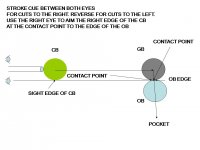My eyes happen to be 2.25 inches apart or the diameter of a CB, so if I stroke my cue under my chin between my eyes, each eye would be aligned with the outer edges of the CB looking at the OB.
I think that I can use this configuration to aim the edge of the CB at the double distance from the contact point that sends the OB to the pocket/target to the edge of the OB.
This would be without shifting or pivoting the cue.

????:smile:
I think that I can use this configuration to aim the edge of the CB at the double distance from the contact point that sends the OB to the pocket/target to the edge of the OB.
This would be without shifting or pivoting the cue.

????:smile:
